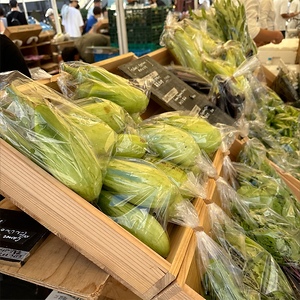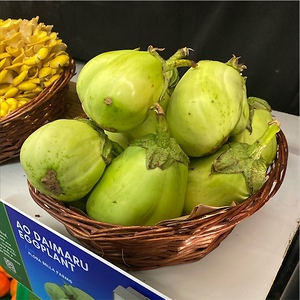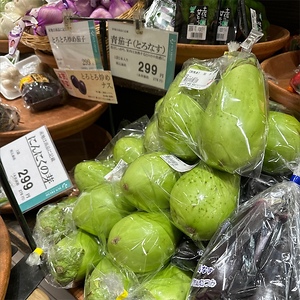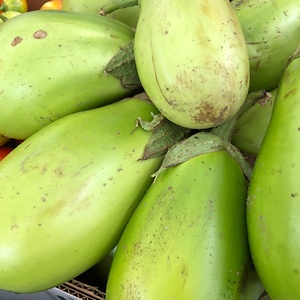


Green Eggplant
Estimated Inventory, lb : 0
Description/Taste
Green eggplants widely vary in size and shape, depending on the variety, but generally average 9 to 30 centimeters in length and appear in globular, oval, to long and cylindrical shapes. The eggplant’s skin is smooth, glossy, and slightly waxy, ranging in color from light green, dark green, to green with speckled white patches. The eggplants are also capped with a green to dark green leathery calyx with a small, stubby stem and have a plump, unblemished surface and a firm consistency. Underneath the skin, the white to ivory flesh is dense and spongy with a few edible seeds. Green eggplants must be cooked and develop a meaty, tender, and soft texture when heated. The eggplants also have a mild, sweet flavor with subtle earthy nuances and fewer bitter notes than other colored eggplant varieties.
Seasons/Availability
Green eggplants are available in the late spring through fall.
Current Facts
Green eggplants, botanically classified as Solanum melongena, are mild and sweet varieties belonging to the Solanaceae or nightshade family. There are many types of eggplants generally labeled as Green in commercial markets, and the pale-hued cultivars have a concentrated presence throughout produce stalls in Asia. Green eggplants widely vary in appearance in Southeast Asia and Eastern Asia and are also known as Green Aubergine. There are several cultivars with specific branded names, including Thai Long Green, Green Elephant Tusk, Hari, Green Knight, Choryoku, Bangladeshi Long, and Little Green Eggplant. Green eggplants can be used similarly to purple eggplants in cooked preparations and generally contain a sweeter, milder, and less bitter flavor.
Nutritional Value
Green eggplants are an excellent source of fiber to regulate the digestive tract, vitamin C to strengthen the immune system and reduce inflammation, and potassium to balance fluid levels within the body. The eggplants also provide iron to develop the protein hemoglobin for oxygen transport through the bloodstream, calcium to protect bones and teeth, and other nutrients such as manganese, B vitamins, and copper. In Japanese natural medicines, eggplant is believed to have a cooling, diuretic effect, discharging heat from the body. A Japanese proverb warns not to feed a bride eggplant in the fall as it will cool the bride’s body temperature to the point where she won’t be able to have children.
Applications
Green eggplants have a sweet and mild flavor, well suited for savory preparations. The eggplants must be cooked before consumption and are popularly grilled, roasted, stir-fried, baked, or sautéed. Green eggplants develop a tender and creamy consistency when cooked and can be chopped and mixed into soups, curries, and stews, incorporated into stir-fries, fried into tempura, or sliced and roasted as a side dish. The eggplants can also be coated in cheeses or breadcrumbs and baked, grilled and layered into sandwiches, or roasted with other vegetables. In Japan, Green eggplants are incorporated into dashi soup for added texture and are pickled to make tsukemono. Pickled dishes in Japan are used as a palate cleanser, and eggplant is commonly preserved in miso, vinegar, salt brines, or plum vinegar. Green eggplants pair well with tofu, herbs such as basil, cilantro, and curry leaves, sauces including soy sauce, sesame oil, miso, and coconut milk, chickpeas, broccoli, tomatoes, bell peppers, carrots, ginger, garlic, and spices including garam masala, coriander, and turmeric. Whole, unwashed Green eggplants will keep up to three days when stored in a cool and dry place.
Ethnic/Cultural Info
In the Saitama prefecture in Japan, there is a variety of Green eggplant known as Ao Daimaru, a kyo yasai or Kyoto vegetable. Kyo yasai is a traditional grouping of Japanese heirloom vegetables that have a unique flavor, texture, and appearance. Ao Daimaru eggplants are cooked in simple preparations to showcase their natural, rich flavoring, and the variety is sometimes known as Midori Nasu or Ao Nasu. In Yachiyo city, located within the Chiba prefecture, adjacent to the Saitama prefecture, the Green eggplant is the mascot for an elementary school because of its cultural and economic significance. Before the Meiji period, when Tokyo was known as Edo, the Chiba prefecture was considered Edo's pantry for its farms and fertile soils. The prefecture also grew the rare Ao Daimaru, regarded as a specialty of the Edo period, and produced other Green eggplant cultivars for sale throughout the county.
Geography/History
Green eggplants are native to India, China, and other regions of eastern Asia and have been cultivated for thousands of years. There are many different varieties with various histories, but over time, Green eggplants were selectively bred to showcase improved flavors, appearances, and textures. Green eggplants were also introduced to Japan in the early ages for commercial cultivation and home gardens. In 1868, the beginning of the Meiji period, Green eggplants became a delicacy throughout Japan, and the pale-hued eggplants are still grown in the regions surrounding Tokyo. Today Green eggplants are found through local markets, farm stands, grocers, and distributors throughout Asia. Some Green eggplant varieties are also cultivated on a small-scale through specialty farms in Australia, Europe, and the United States.
Recipe Ideas
Recipes that include Green Eggplant. One
| The Guardian |
|
Stir Fried Eggplant + Thai Basil in Yellow Bean Sauce |
| Not Eating Out In New York |
|
Fried Green Eggplant with Peach Salsa |
| Masala Korb |
|
Green Eggplant Potato Curry |











